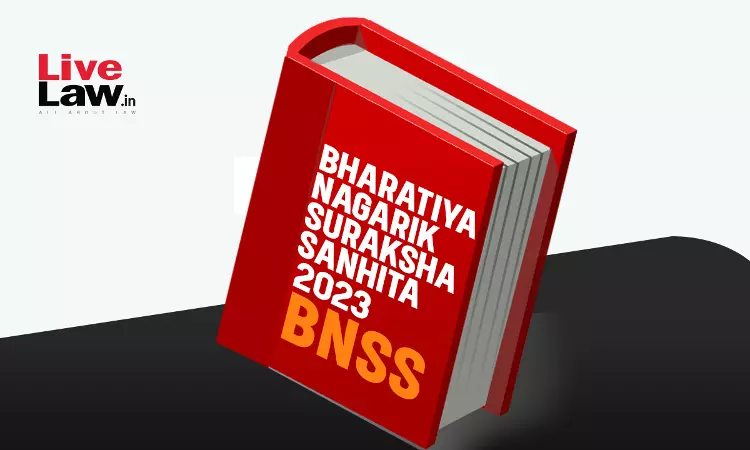Cognizance And Criminal Complaints: A New Perspective In The BNSS Era
Anirban Senapati.
23 April 2025 10:10 AM IST

The concept of cognizance has been debated in the discourse on criminal law in India. The meaning of the term “cognizance” has been mystifying since it has been nowhere defined in the Criminal Procedure Code or the Bharatiya Nagarik Suraksha Sanhita. Black's Law Dictionary defines the term “cognizance” as 'jurisdiction', or 'exercise of jurisdiction', or 'power to try and determine causes'.[1] As a result, over the years, the Supreme Court has developed the meaning of this term through various precedents. However, with the changes in Bharatiya Nagarik Suraksha Sanhita, the concept of cognizance, particularly concerning criminal complaints, needs to be discussed again with a fresh outlook.
Cognizance and criminal complaints in the Code of Criminal Procedure, 1973:
On a plain reading of the provisions of the Code, it seems that cognizance is associated with the initiation of taking judicial notice. This is separate from the provision of the issue of process under Chapter XVI, and the landmark judgment of R.R. Chari vs. State of Uttar Pradesh[2] also supports this view. In this case, C.J. H.J. Kania held that the aspect of taking cognizance does not involve any formal action, but it occurs as soon as the Magistrate applies his mind to the suspected commission of the offence.
However, the complications start when we proceed to the “Complaint to Magistrates” Chapter. Let us read the starting line of Section 200, "A Magistrate taking cognizance of an offence on complaint shall examine upon oath the complainant and the witnesses present, if any, and the substance of such examination shall be reduced to writing and shall be signed by the complainant and the witnesses, and also by the Magistrate…”. Quite naturally, a doubt occurs in our mind: whether this exercise ventured upon by the Magistrate to examine the complainant and witnesses present, if any, occurs before or after the process of taking cognizance? Should the Magistrate only examine the complainant and witnesses present after taking cognizance or in the process of taking it?
The Supreme Court has clarified this question of law through various precedents. In the case of H.S. Bains, Director, Small Saving-Cum-Deputy Secretary Finance, Punjab, Chandigarh v. State,[3] the Apex Court observed that a Magistrate may take cognizance of an offence and proceed to record statements of the complainant and the witnesses present under Section 200. Thereafter, if there is sufficient ground for proceeding against the accused, he would issue process under Section 204, otherwise the complaint may be dismissed under Section 203. Similarly, in Darshan Singh Ram Kishan v. State of Maharashtra,[4] it has been held, “As has often been held taking cognizance does not involve any formal action or indeed action of any kind but occurs as soon as a Magistrate applies his mind to the suspected commission of an offence”. Another illuminating precedent on this concept is State of Karnataka v. P. Pastor Raju,[5] where it has been held, “Cognizance is taken at the initial stage when the Magistrate applies his judicial mind to the facts mentioned in a complaint or to police report or upon information received from any other person that an offence has been committed.” Thus, the point of law is clear in this respect: the exercise under Section 200 of the examination of the complainant and witnesses comes after the process of taking cognizance.
The Changes in BNSS and the Effect
The Bharatiya Nagarik Suraksha Sanhita came into force from 01st July, 2024. It introduced one interesting change from the Code of Criminal Procedure: the complainant now needs to be heard before taking cognizance. However, the rest of the provision of examination of the complainant has remained almost the same, except for adding procedural safeguards for public servants and now specifying clearly about the Magistrate “having jurisdiction” in the starting line of Section 223.
This begs the question now: At what point will the Magistrate take cognizance? Although the word cognizance has retained its place in the starting line of the Section, with the aspect of hearing the accused before taking cognizance, there remains a grey area, especially in light of two recent observations by the Karnataka High Court and the Kerala High Court. In Basanagouda R Patil (Yatnal) and Shivananda S Patil,[6] Justice M Nagaprasanna has observed that the first step taken by the Magistrate would be examining the complainant on oath and witnesses present, if any, then issuing notice to the accused while appending the sworn statement and the statement of the witnesses (if any), and then hearing the accused after his or her appearance, only after that would cognizance under Section 223 of BNSS take place. In Suby Antony v R1 (Deleted),[7] the Kerala High Court, in a similar vein, observed that “…after the complaint is filed, the Magistrate should first examine the complainant and witnesses on oath and thereafter, if the Magistrate proceeds to take cognisance of the offence/s, opportunity of hearing should be afforded to the accused.” Thus, Justice V. G. Arun quashed the notice issued to the accused person and instructed the Magistrate to examine the complainant and the witnesses, if any, on oath, and then proceed to issue notice to the accused person and finally hear the accused if the Magistrate decides to take cognizance of the offences.
Following these two rulings, it can be seen that the process of taking cognizance under the new law has seemingly now undergone a consequential shift where the complainant and witnesses present, if any, are examined, after which the accused has appeared in pursuance of the notice issued to him, and then the application of mind or cognizance takes place after hearing the accused. This starkly contrasts with the principle followed under the Code of Criminal Procedure, where the Supreme Court observed that cognizance does not involve taking action of any kind. Even a cursory look at the statutory provision of Section 223 would reveal that the Sanhita has now mandated at least hearing the accused before taking cognizance, thus implying that the judicial application of mind would also now involve at least hearing the accused who has appeared after receipt of the notice. Interestingly, the Supreme Court's decision in S.R. Sukumar[8] might be relevant to this context. The Apex Court here observed that in the circumstances of the impugned case, when cognizance was taken by the trial Court and thereby statements were recorded under Section 200, the cognizance under Section 200 that was recorded in the order sheet was not grounded in reality, and actual cognizance was taken only later when the Magistrate decided to proceed against the accused person having committed the offence. For BNSS, this might be one way of looking at this aspect, as actual cognizance would be taken only after hearing the accused person(s).
Over the years, the concept of cognizance has evolved through various precedents. Although a specific definition is clearly absent in statute books, the principle has been established as the application of the mind to the suspected commission of the offence. The introduction of the opportunity of hearing provided to the accused under BNSS presents an intriguing scenario for this concept, and a decision is awaited from the Apex Court regarding how the concept of cognizance would further develop now.
The author is a Civil Judge(Jr. Div.)-cum-Judicial Magistrate First Class, Sonamura, Sepahijala, Tripura. Views are personal.


